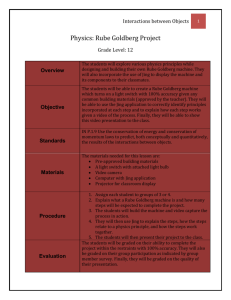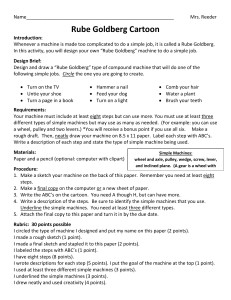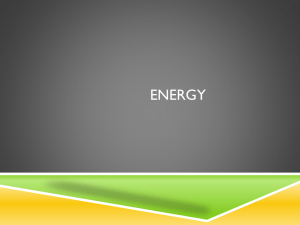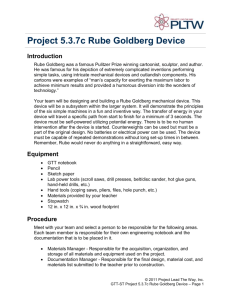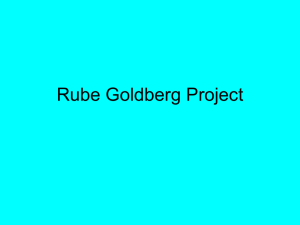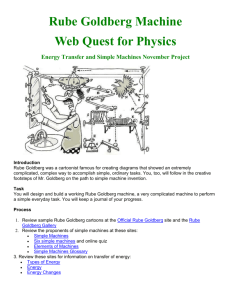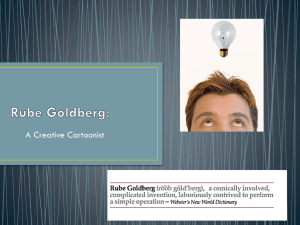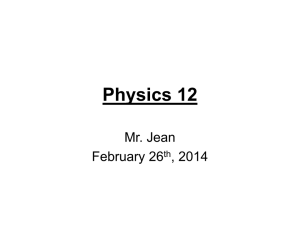Rube Goldberg Energy Transfer Machine
advertisement
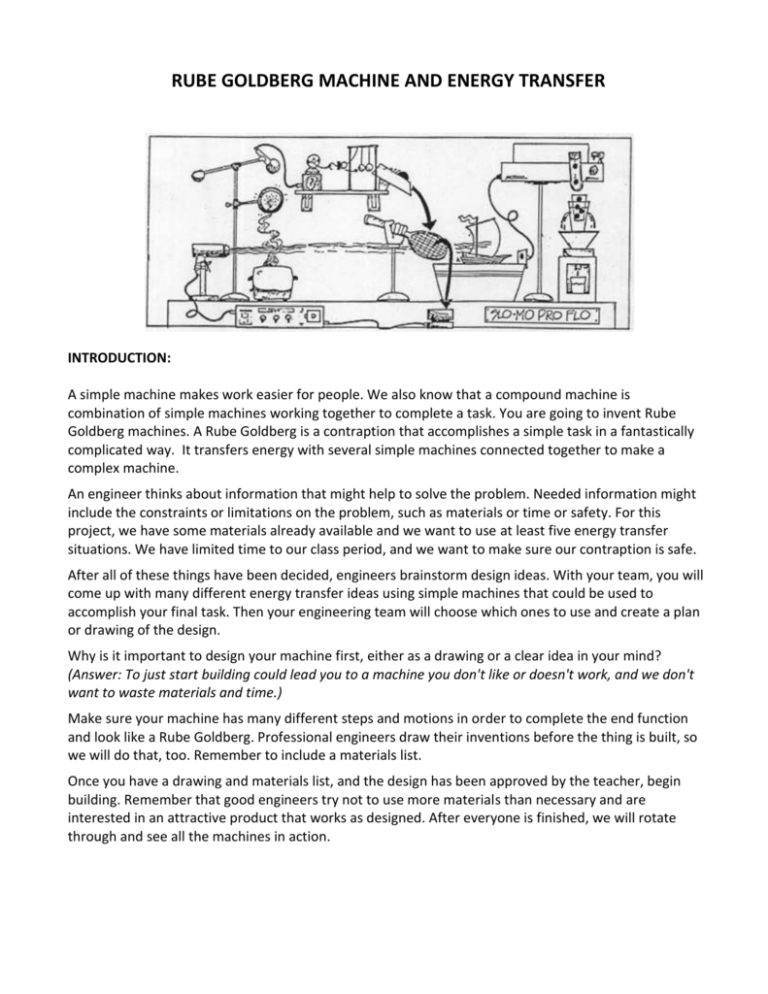
RUBE GOLDBERG MACHINE AND ENERGY TRANSFER INTRODUCTION: A simple machine makes work easier for people. We also know that a compound machine is combination of simple machines working together to complete a task. You are going to invent Rube Goldberg machines. A Rube Goldberg is a contraption that accomplishes a simple task in a fantastically complicated way. It transfers energy with several simple machines connected together to make a complex machine. An engineer thinks about information that might help to solve the problem. Needed information might include the constraints or limitations on the problem, such as materials or time or safety. For this project, we have some materials already available and we want to use at least five energy transfer situations. We have limited time to our class period, and we want to make sure our contraption is safe. After all of these things have been decided, engineers brainstorm design ideas. With your team, you will come up with many different energy transfer ideas using simple machines that could be used to accomplish your final task. Then your engineering team will choose which ones to use and create a plan or drawing of the design. Why is it important to design your machine first, either as a drawing or a clear idea in your mind? (Answer: To just start building could lead you to a machine you don't like or doesn't work, and we don't want to waste materials and time.) Make sure your machine has many different steps and motions in order to complete the end function and look like a Rube Goldberg. Professional engineers draw their inventions before the thing is built, so we will do that, too. Remember to include a materials list. Once you have a drawing and materials list, and the design has been approved by the teacher, begin building. Remember that good engineers try not to use more materials than necessary and are interested in an attractive product that works as designed. After everyone is finished, we will rotate through and see all the machines in action. PROJECT SPECIFICATIONS FOR YOUR MACHINE: 1. 2. 3. 4. The machine should perform one task. The machine should be stable and can stand on its own. The machine may not be larger than a lab table. The machine should be made using items found at home or borrowed from a friend. Please do not purchase anything for this project. 5. The machine cannot take longer than 10 minutes to set up. 6. A “blueprint” must be drawn to turn on the day you present your machine. Indicate the START and FINISH of your machine. Use arrows to trace the route of movement. TIPS: Look for easy to handle, durable materials. Check out your closets, toy boxes (sister or brother’s room?), garage or junk drawers. SAFETY: As you build your contraption, keep in mind that safety must be your first concern. Check with your teacher if you have any questions. IDEAS FOR MACHINES: Kleenex out of a box Launching a paper airplane Golf ball in a hole Ring a bell Toothpaste on a brush Put ice in cup Hit a target with something Turn on a flashlight Switch something on Staple something Pour milk on cereal or ANY OTHER SIMPLE TASK PART 1: DESIGN THE RUBE GOLDBERG MACHINE 1. In groups of three, have student engineering teams decide on simple tasks to create machines for, intended audiences, and any information they know that will help them solve the problem. 2. Google – Rube Goldberg Machines Middle School. Search for ideas and watch videos. 3. With every group member contributing ideas, have students brainstorm ideas about how they will accomplish the simple task (such as getting a marble in a cup one meter away) in an overly complex way. Remind them that they must use at least five energy transfers in their final designs. 4. Brainstorm possible paths that you could take to create the action you chose for your project. Consider moving parts that you might use to create the machine. Common objects used to trigger or power these types of projects include balloons, bowling balls, ball bearings and rubber bands. 5. Next, have each team collectively produce machine drawings that include dimensions and label materials to be used and energy transfer. 6. Have teams include materials lists, including any special-request materials. Identify your supplies from available objects. Explore your classroom and home for potential parts to inspire your Rube Goldberg machine. The more unusual components, the better. 7. Teams show their designs and materials lists to the teacher for approval. 8. Have students make design alterations if not immediately approved. After approval, make the design more specific or the drawing more detailed as other groups finish up their designs. 9. During the first part of the activity, which is the design of the machines, the following materials will be available for them. construction paper marbles small paper cups (such as Dixie cups) paper towel tubes string jumbo paper clips rubber bands hot glue PART 2: BUILD THE RUBE GOLDBERG 1. Have students spend a few minutes reviewing their drawings from Part 1 before starting to build. 2. Have student teams gather their materials and begin to build their designs. ALL each group member must participate in building. Follow the planned design as closely as possible. 3. Brainstorm possible paths that you could take to create the action you chose for your project. Consider moving parts that you might use to create the machine. Common objects used to trigger or power these types of projects include balloons, bowling balls, ball bearings and rubber bands. 4. Write down the steps as you intend them to happen, in a numeric sequence that matches the planned sequence for triggering the Rube Goldberg project. Include details about how you intend to execute each step, including the materials and tasks necessary to get from one step to the next. 5. Once completed, test machine. 6. Complete Machine Flow Chart GRADING RUBRIC Points possible Rough Sketch with labels 5 Successful Start Through 1st – 2nd Without stopping through 2nd and 3rd 5 5 Without stopping through 3rd to 4th 5 Without stopping through 4th to 5th 5 Machine runs without any touches 10 Creativity and Design 5 Final Drawing with labels 10 Completed Flow Chart 25 Points Earned

